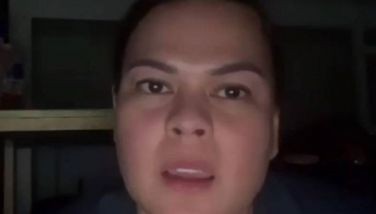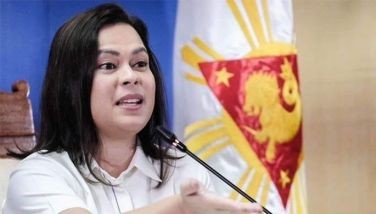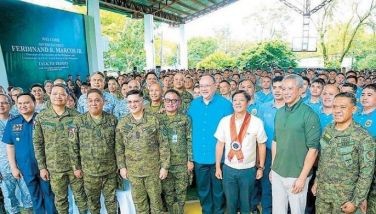‘Ambo’ to usher in typhoon season
March 4, 2004 | 12:00am
Fearless weather forecast: This year’s typhoon season will be ushered in by a tropical cyclone named "Ambo."
Unknown is when "Ambo" will actually hit the country. "Ambo" is one in a series of 25 names prepared in advance by the Philippine Atmospheric, Geophysical and Astronomical Services Administration (PAGASA) of the Department of Science and Technology (DOST).
Yes, 25 names have been prepared for the 25 howlers expected to slam into the so-called "Philippine area of responsibility" this year.
Among the names are such beauties as Kenkoy, Osang, Giling and Viajero.
Of the cyclone names, nine are recognizably masculine —Ambo, Cosme, Enteng, Inggo, Julian, Nonoy, Totoy, Yoyong and Zosimo. The feminine names are Biday, Flor and Osang.
The rest are either monikers, names of animals or action words — Dugong, Giling, Hataw, Kenkoy, Lawin, Manoy, Pandoy, Quinta, Rigodon, Sigla, Usa, Viajero and Wasiwas.
In case more than 25 typhoons hit the country, PAGASA also has a ready list of auxiliary names — Alakdan, Baldo, Carayan, Dagundong, Estong, Fuerte, Gardo, Harabas, Ikot and Julio.
Or did you know that all the typhoons that will hit the country from 2005 to 2016 already have names?
Vicky Bautista and Cheryl Berin of the DOST Science and Technology Information Institute (STII) explained that in 1999, PAGASA conducted a nationwide search for a new generation of tropical cyclone names. Dubbed "Name a Bagyo Contest," the search yielded 140 new, non-gender-biased local names out of more than 18,000 entries.
The series of typhoon names will be used in four-year cycles. For instance, the names to be used this year will be the same as those in 2008.
The tropical cyclone naming system in the local scene has a bearing on the international coding system of the Typhoon Committee of the United Nations Economic and Social Commission for Asia and the Pacific (UN-ESCAP) and the World Meteorological Organization (WMO).
As a member of the typhoon committee, PAGASA complies with the new naming scheme drafted in the 31st session of the committee held in the Philippines Dec. 1—7, 1998.
PAGASA started using the new names on Jan. 1, 2000. Before 1890, the world’s tropical cyclones were named arbitrarily.
But by the end of the 19th century, an Australian named C. Wragge started giving cyclones female names.
The naming of storms became so popular that air force and navy forecasters started giving their wives and girlfriends the distinction of having storms named after them.
In 1947, weather forecasters decided to identify storms using names in alphabetical order.
Then known as the Philippine Weather Bureau, PAGASA adopted the system in 1963 by devising four groups of Filipino women’s nicknames beginning with letters from A to Y and ending in "ng" for all tropical cyclones within the Philippine area of responsibility.
Unknown is when "Ambo" will actually hit the country. "Ambo" is one in a series of 25 names prepared in advance by the Philippine Atmospheric, Geophysical and Astronomical Services Administration (PAGASA) of the Department of Science and Technology (DOST).
Yes, 25 names have been prepared for the 25 howlers expected to slam into the so-called "Philippine area of responsibility" this year.
Among the names are such beauties as Kenkoy, Osang, Giling and Viajero.
Of the cyclone names, nine are recognizably masculine —Ambo, Cosme, Enteng, Inggo, Julian, Nonoy, Totoy, Yoyong and Zosimo. The feminine names are Biday, Flor and Osang.
The rest are either monikers, names of animals or action words — Dugong, Giling, Hataw, Kenkoy, Lawin, Manoy, Pandoy, Quinta, Rigodon, Sigla, Usa, Viajero and Wasiwas.
In case more than 25 typhoons hit the country, PAGASA also has a ready list of auxiliary names — Alakdan, Baldo, Carayan, Dagundong, Estong, Fuerte, Gardo, Harabas, Ikot and Julio.
Or did you know that all the typhoons that will hit the country from 2005 to 2016 already have names?
Vicky Bautista and Cheryl Berin of the DOST Science and Technology Information Institute (STII) explained that in 1999, PAGASA conducted a nationwide search for a new generation of tropical cyclone names. Dubbed "Name a Bagyo Contest," the search yielded 140 new, non-gender-biased local names out of more than 18,000 entries.
The series of typhoon names will be used in four-year cycles. For instance, the names to be used this year will be the same as those in 2008.
The tropical cyclone naming system in the local scene has a bearing on the international coding system of the Typhoon Committee of the United Nations Economic and Social Commission for Asia and the Pacific (UN-ESCAP) and the World Meteorological Organization (WMO).
As a member of the typhoon committee, PAGASA complies with the new naming scheme drafted in the 31st session of the committee held in the Philippines Dec. 1—7, 1998.
PAGASA started using the new names on Jan. 1, 2000. Before 1890, the world’s tropical cyclones were named arbitrarily.
But by the end of the 19th century, an Australian named C. Wragge started giving cyclones female names.
The naming of storms became so popular that air force and navy forecasters started giving their wives and girlfriends the distinction of having storms named after them.
In 1947, weather forecasters decided to identify storms using names in alphabetical order.
Then known as the Philippine Weather Bureau, PAGASA adopted the system in 1963 by devising four groups of Filipino women’s nicknames beginning with letters from A to Y and ending in "ng" for all tropical cyclones within the Philippine area of responsibility.
BrandSpace Articles
<
>
- Latest
- Trending
Trending
Latest
Trending
Latest
Recommended




























